Film Music Editor: Ian Lace |
||
November 1999 Film Music CD
Reviews |
|
|
Return to the November Index with thumbnails [ Part 1 ] [ Part 2 ] [ Part 3 ] [ Part 4 ]
We commence with two more video reviews (with special reference to the music) in our series The Films of Alfred Hitchcock
Maurice JARRE’s music for Alfred Hitchcock’s TOPAZ starring Frederick Stafford, John Forsythe, John Vernon, Dany Robin, Michel Piccoli,Philippe Noiret, Roscoe Lee Brown
Universal Home Video 044 9223 purchase from Yalplay
THE PLOT
Leon Uris' novel supposes a tangled international espionage resolution to the Cuban Missile Crisis in 1962. The Deputy Chief of the KGB defects to the West providing all sorts of information. The Americans want to know what the Russians are providing the Cubans with, and enlist the aid of a French Embassy operative (Devereaux). Complications ensue in obtaining the information with a doomed love affair, that leads to Devereaux ordered to report his activities to the French authorities. The Russian defector reveals a spy ring of French officials working for the Russians called Topaz. This makes Devereaux's job impossible on returning to Paris. Eventually, by bluffing and outright accusation the traitors hands are forced, and the Crisis is over almost before it begins.
THE MUSIC
You have to hope Hitchcock's thinking behind hiring Jarre wasn't as simple as getting a Frenchman to write music for a Frenchman. Whether or not that was the case, that's what you get - an accordion for Devereaux's every appearance. Whether in New York, Washington, Cuba, or Paris - the instrument is his motif and an increasingly irritating one. At the most inappropriate of times, this high frequency instrument cuts across dialogue or action in a very distracting manner. An example is a tense office scene which is underscored for accordion and a kitchen sink assortment of percussion. This is a complicated film that falls flat through only the vaguest of dramas seeming wholly un-interesting between too many throwaway characters. There's much of James Bond about Devereaux, but even when showing off his technical goodies, the score merely plays on some woodblocks underneath the accordion.
The cues are drastically short, and although many segue scenes together there's no correlative sense from start to end. A harpsichord takes over for the love affair with Juanita de Cordoba, but even this cannot save a truly cut and paste soundtrack. The real musical star is the only thing you'll find acknowledged on any collection: The March that opens and closes the film.
Reviewer
Paul Tonks

John WILLIAMS’ music for Alfred Hitchcock’s FAMILY PLOT Universal Home Video 044 5513 purchase from Yalplay
Family Plot was Hitchcock’s last film and John William’s first and only score for the master of suspense. Family Plot was more of a black comedy than a thriller with no murders, (at least at the time of the action) and no thrilling final climax. The critics were divided about this unusual film in the Hitchcock canon. Yet time has been kind to it and I for one appreciate it much more now than when I first saw it in 1976; its virtues probably suit the small screen better for, as Halliwell says: "…this is a Hitchcock suspenser in an unusually friendly vein."
The Plot
Madam Blanche, a medium on the make, is asked by elderly wealthy Miss Rainbird to find her missing grandson. Miss Rainbird had banished both him and his mother because his illegitimacy would have besmirched the family name. Blanche (Barbara Harris) and her cab driver boyfriend George (Bruce Dern) make enquiries. George learns that the grandson, Edward, is dead but when he visits the cemetery to visit the family plot he discovers that Edward has a newer and separate gravestone to that of his parents buried alongside. George’s suspicions are aroused and he visits garage owner Muloney who had erected Edward’s gravestone. Muloney in panic goes to see Edward who is alive and well and living under the alias of jeweler Arthur Adamson (William Devane). Meanwhile Blanche gets another clue from Miss Rainbird about somebody else who knew Edward – a priest who is now a bishop. George hurries to the Cathedral to interview the bishop only to see him kidnapped by Arthur and Fran (Karen Black). They are professional kidnappers ransoming their victims for priceless diamonds. We had actually met Fran earlier when she picks up a jewel and returns a kidnapped victim. A perfect integrating of plot elements this as Hitchcock has George nearly run over Fran, heavily disguised and on her way to the pick-up point. (George and Blanche are returning from their first meeting with Miss Rainbird.) Complications ensue with Blanche and George just interested in tracking down Edward/Adam for Miss Rainbird so that they can earn their $10,000 fee. Adam, on the other hand, is more interested in keeping them off his trail because he thinks they are pursuing him as the kidnapper and even tells Muloney to kill them in an auto ‘accident.’ How Blanche and George capture the villains forms the thrilling and amusing climax to the story.
The Music
The few recordings that exist of this score concentrate entirely on the End Titles which neatly sum up all the major themes into a nice cohesive mini-suite. The Varese Sarabande Alfred Hitchcock recording has the best of these (together with suites from Suspicion, Strangers on A Train and Notorious.) This policy is understandable because Hitchcock uses John Williams’s music comparatively sparingly. For instance, he follows his precedent set for the crop spraying sequence in North by North West by not employing any music at all to underscore the sequence where Blanche and George go hurtling down the mountain road in their car which that has been disabled by Maloney. The music only starts when Maloney comes to investigate their "deaths" but seeing them alive turns his car and prepares to run them down in a second assassination attempt. Forte tympani rolls support crashing staccato string chords as Maloney advances. Williams uses his tympani prominently throughout this score. Their rolls and beats are most pronounced in the early scene where Fran in blonde wig and high boots marches up to collect the ransom to an additional accompaniment of snare drums, a harpsichord carrying the melodic line, and electronic organ whinings. The tympani alone, in staccato, almost heart-beatings underscore the scene in Adams jewelry shop where the police interview him. But the most bizarre usage is in the cemetery scene where they are reinforced by a forte stroke of the bass drum when we first see the graves of Edward and his parents (Arthur/Edward having killed his parents with the aid of Maloney some years previously). As the gravedigger emerges from a hole several yards away we hear some grisly low woodwind figures and a piano plays a cold remote version of the theme associated with Fran and Arthur.
The other major element in the score is for the opening séance sessions. An other-worldly choir hums a sweet sentimental soaring melody supported by violins, and harp arpeggios
to such magnificent effect that you are almost taken in, by Blanche, as much as Miss Rainbird.
After such a promising start, it seems a great pity that Hitch did not live long enough to allow his new collaboration with Williams to develop. Who knows, it might have rivaled that of Hitchcock/Herrmann!
Reviewer
Ian Lace
Video Film
Music
This month we celebrate Film Scores for Shakespeare with a selection of reviews by our contributors of scores old and new that have particularly impressed them .
First though as a reminder we list some of the scores, for films of Shakespeare plays that readily come to mind:-
Antony And Cleopatra (John Scott)
Chimes At Midnight (Falstaff)(Angelo Francesco Lavagnino)
Hamlet (William Walton)
Hamlet (Ennio Morricone)
Hamlet (Patrick Doyle)
Hamlet (Dimitri Shostakovich)
Henry V (Patrick Doyle)
Henry V (William Walton)
Macbeth (Jacques Ibert)
Macbeth (William Walton)
A Midsummer Night's Dream (Erich Wolfgang Korngold)
A Midsummer Night's Dream (Simon Boswell)
Much Ado About Nothing (Patrick Doyle)
Othello (Aram Khachaturian)
Othello (A.F. Lavagnino/Alberto Bargeris)
Othello (Charlie Mole)
Othello (Elliot Goldenthal)
Richard III (Trevor Jones)
Richard III (Ennio Morricone)
Richard III (William Walton)
Romeo & Juliet (Nino Rota)
The Taming Of The Shrew (Nino Rota)
Twelfth Night (Shawn Davey)Then there are films inspired by Shakespeare like
Forbidden Planet (1956) (‘The Tempest’)
Shakespeare In Love (Stephen Warbeck)The list could go on and on….
The Reviews
A very useful aid to understanding Shakespeare is –
Narrators: Sir Derek Jacobi and Jane Lapotaire
DELOS DE 6008 4 CDs [4hrs 22mins]
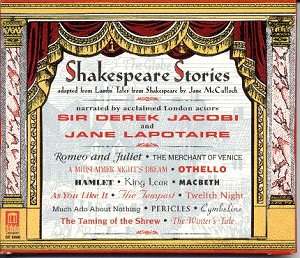
The stories:
Romeo and Juliet
The Merchant of Venice
A Midsummer Night’s Dream
Othello
Hamlet
King Lear
MacbethAs You Like It
The Tempest
Twelfth Night
Much Ado About Nothing
Pericles
Cymbeline
The Taming of the Shrew
The Winter’s Tale
Most of us, at some time or other, have experienced that sinking feeling when confronted with a Shakespeare play. All those characters, all those plot twists. Have I understood it properly? Have I missed something? English Literature classes at school may have helped but many of us will have forgotten them or were antagonistic to them – then. Even the professionals, the actors themselves, will admit that they, too, can be daunted by Shakespeare. It is an age-old problem and one that was addressed by Charles Lamb, and his sister Mary, in their book Lambs’ Tales of Shakespeare.
Lambs’ Tales from Shakespeare was first published in 1807 and was hailed as a unique and brilliant literary work. Mary’s name was omitted from the first edition - probably because her brother’s name was better known, but it is possible that it was Mary’s own wish that her name be suppressed. However her brother conceded the importance of her contribution and her name appeared on subsequent editions. Writing to Wordsworth, Charles wrote, "I am responsible for Lear, Romeo, Macbeth, Hamlet, The Tempest and Othello. The rest is my sister’s work. It is our hope that the tales having been read and understood by the young, the true plays may then prove to them, in older years, enrichers of fancy, strengtheners of virtue, a withdrawing from all mercenary and selfish thoughts and a lesson of all sweet and honourable actions, for in teaching these great human virtues, Shakespeare’s plays are full."
The Lambs’ policy was for the narrative of the tales to be interwoven with the very words of Shakespeare wherever possible. Some of Shakespeare’s plays were omitted. There are none of the English histories, nor any of the Roman plays; and, for some reason, Love’s Labours Lost was omitted from the comedies.
Sir Derek Jacobi and Jane Lapotaire are excellent narrators colouring their voices according to the wonts of Shakespeare’s characters and bringing the stories vividly to life. Some of the Lambs’ adaptations are more successful than others. Hamlet is a small miracle of condension but a lot of the detail of some of the plays is frustratingly omitted. For instance, in A Midsummer Night’s Dream, the play within a play performed by Bottom and his troupe of craftsman actors is omitted, so too are the comic capers of Malvolio and Sir Toby Belch from Twelfth Night. Nevertheless this is a marvellous production, enhanced by Célia Medaglia’s lute playing of works by Dowland and Holborne between the tales. Full credit should also go to the adapter of the stories, Jane McCulloch. This 4-CD set is a fine introduction or reminder of the Bard’s works for people of all ages. Strongly recommended as a Christmas present.
Reviewer
Ian Lace

************************************************************** EDITOR’S CHOICE – November 1999
**************************************************************
OST
DECCA 466 098 2 [71:30]
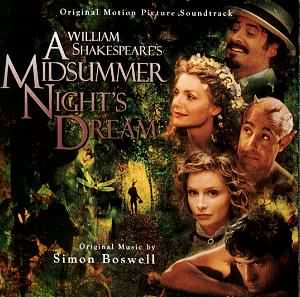
Source Music:-
Mendelssohn: A Midsummer Night’s Dream - Overture and Wedding March
Verdi: La traviata – Brindisi (Renée Fleming and Marcello Giordani)
Puccini: La Bohème - Che gelida manina (Luciano Pavarotti)
Bellini: Norma – Casta diva (Renée Fleming)
Mascagni: Cavalleria rusticana - Intermezzo
Donizetti: L’elisir d’amore – Una furtiva lagrima (Roberto Alagna)
Rossini: La Cenerentola – Non più mesta (Cecilia Bartoli)This is a truly entrancing album. Hoffman’s film version of Shakespeare’s immortal comedy of errors might not have greatly impressed the critics, but Simon’s Boswell’s score, and the choice of source music is inspired. It comprises excerpts from Mendelssohn’s original music for the Shakespeare play (conducted by Ashkenazy) together with popular arias from Italian opera, sung by Decca’s opera super stars.
Boswell’s score commences with ‘The course of true love’ a sentimental, romantic piece for strings with isolated woodwind colourings. This is salon music of the turn-of-the-century and suggests not only Elgar but also French and Italian music of that genre too. An exquisite little creation.
The booklet notes tell us that Boswell was influenced by a wide spectrum of music in writing this score, from ancient music to diverse popular traditions (Indian, Bulgarian, Syrian, Egyptian, Caribbean, African to name but a few) plus Mozart, Stravinsky and Ravel etc. His talent blends all these diverse influences into a remarkably evocative score. Not since Jerry Goldsmith’s Legend score, have I heard music that so successfully portrays the land of the fairies. ‘Between the cold moon and the earth’, is magically beautiful; full of fairy-light tinklings, shimmerings, ripplings and flutterings to and fro across the sound stage. ‘Hot ice’ is buffoonery with pipes and tambour – a merry and satirical dance, wickedly witty. ‘The forgeries of jealousy’ is altogether darker and disturbing as befits the green-eyed monster, sensual hot-house music laced with menace. ‘I know a place where the wild thyme grows…’ is pastoral and gently romantic with soft zephyr breezes playing and fairy dust scattering over lovers’ bowers. (A narration of Shakespeare’s well-loved verse might have been an attractive bonus here)
‘What fools those mortals be’ is another busy little number in the Italian style with delightful languid, romantic moments. ‘Strange snow’ is a strange rustic dance which reminds one more of the bazaars of North Africa but its incorporation of some unusual instrumentation like Caribbean steel drums and its infectious rhythms makes it irresistible. ‘Fair lovers you are fortunately met’ is an arrangement, by music editor Robert Randles, of the beguiling horn melody and imposing brass fanfares from Mendelssohn’s A Midsummer Night’s Dream. Finally Boswell arranges Mascagni’s Cav. music for ‘A most rare vision’ and reintroduces some of the salon-type material with which the score opened.
Just a word about the source music – these marvellous arias are worth the price of the CD alone. Pavorotti’s Puccini aria comes from the prized Karajan recording with Miella Freni as Mimi. Renée Fleming’s ‘Casta diva’ is one to die for, Cecilia Bartoli shows off her coloratura prowess in her Rossini aria and Roberto Alagna is magnificently ardent in the Donizetti.
This album will figure highly in my list of best scores of 1999. Don’t hesitate; rush out and buy this one.
Reviewer
Ian Lace

from Franco Zeffirelli's Paramount film, Romeo & Juliet, 1968.
SILVA SCREEN FILMCD 200 [56:18].
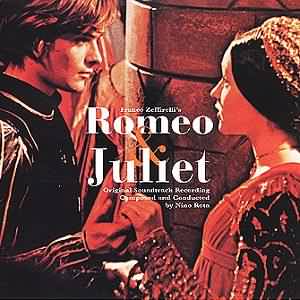
Since the dawn of civilization, when movies began to talk and became big business, there have been several screen adaptations of Shakespeare's most popular play, Romeo & Juliet. But the one that most readily comes to mind is Franco Zeffirelli's splendid version, made in 1968. A stunningly faithful recreation, the film, with Leonard Whiting and Olivia Hussey as the star-crossed lovers, featured glorious colors, thrilling pageantry, a tear-jerking love story that already had defied the ages to become the ultimate romantic drama, and a grandly musical score, solidly anchored around a theme which, in no time, became a popular hit.
The years have done little to diminish the impact of the film, though it took this long for a definitive soundtrack album to finally be released. Originally, Capitol Records in the U.S. had prepared a soundtrack album in conjunction with the release of the film, which contained dramatic highlight and selected musical cues that were, at times, buried under the Bard's dialogues The success of this album eventually compelled the label to issue a full LP of the score, and a boxed set containing the complete soundtrack, both of which were subsequently deleted, never again to be seen. With the advent of CDs, the original album was reissued, with nary a touch of remastering, and matters remained as they were until now.
Rota's magnificent score, properly remastered and minus the bits of dialogue that detracted from it in its previous incarnation, is now back in the catalogue, thanks to Silva Screen's efforts, in a CD that restores it in all its splendor, and with the addition of a previously unavailable "Epilogue." Listening to it, one realizes how much our perception of Rota, as a composer, has been adulterated by his contributions to the films of Federico Fellini, the benchmarks by which we most often judge him. In his many scores for the Italian director, Rota usually let his musical vision parallel Fellini's, to the extent that they often became inseparable, in a close artistic relationship seldom equaled in the annals of the movies (the only other that comes to mind is the one that existed between Alfred Hitchcock and Bernard Herrmann). One of the best examples of this synergy between visual and musical images can be found in both La dolce vita and Juliet of the Spirits, in which Rota's language became a second form of expression to the director's volatile style.
But, as he had demonstrated earlier in War And Peace, Rota could also be totally original and different once he worked away from Fellini. In fact, his greatest achievements in film scoring were for two films directed by others, The Godfather and Romeo And Juliet.
Perfectly capturing in the latter the essence of the Renaissance era, Rota conjured up images of a time gone-by, when two youngsters from feuding families could actually fall in love and die for it, in terms that seemed both of the time evoked and comfortably post-Romantic, quite a feat in itself (an interesting comparison can be drawn with another Zeffirelli adaptation of a Shakespeare play, The Taming Of The Shrew, a rollicking, lusty recreation that also inspired Rota to write one of his most engaging opus).
Giving the score its anchor is the well-known "Love Theme," which pervades it, and which sounds much less obnoxious and much more ravishing in this original context than one might have suspected after having heard it transmogrified so many times by hack pop singers and instrumentalists. But beyond that theme, what surprises here is the richness and sophistication of the entire score, as in the cue marked "Romeo and Juliet Are Wed," in which a boy soprano and an organ mesh to create a strikingly evocative image of beauty and serenity before the storm.
In this new CD edition, Rota's score finally emerges as the masterpiece it always was – quietly elegant, superbly shaded, and altogether supremely melodic, the perfect musical illustration to a perfect screen adaptation of one of the world's best-loved stories.
Reviewer
Didier C. Deutsch

Romeo + Juliet Vol. 2
Premiere Soundtracks PRMDCD34[65:35]

In Volume 1 there was a perfect cross-section of rap, gospel, '70s glam, and indie tracks. It sacrificed any semblance of being a coherent listening experience in favour of cramming in as many audience favourites as possible. Space limitations being what they still are, this second volume was inevitable since the film is almost wall-to-wall music. The reason for that obviously being the huge number of people involved in crafting a soundtrack. You'll be stuck for determining which did what on this disc, since there is no credited breakdown. However, Craig Armstrong's subsequent career (and solo album 'The Space Between Us') make it a fair assumption that the choral "Prologue" is his. It's this cue you'll have heard on numerous film trailers in the last few years.
Like the film, you may feel that the album's first half is its best. The cues are segued together with dialogue soundbites to link disparate elements. The stunted musical telling of the tale therefore follows the same narrative pattern, and it's basically up to the point of the star-crossed lovers meeting and falling in love that the score works its best.
You'll need a focused and forgiving ear to appreciate the chops and changes between styles. Going from the spaghetti western of "Gas Station Scene" to the adagio strings of "Balcony Scene" is quite a stretch. You've got Quindon Tarver's version of Prince's "When Doves Cry" midway for starters.
It's almost a case of too many cooks, but strangely the outcome holds itself together.
Reviewer
Paul Tonks

OST
DRG 32928 [58:30]
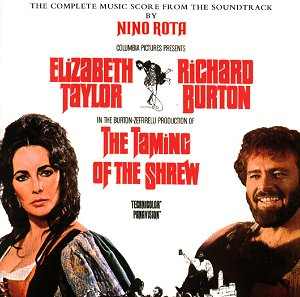
Elizabeth Taylor and Richard Burton were ideally cast as Katherine and Petruchio in Zefferelli’s inspired 1966 production of Shakespeare’s The Taming of the Shrew; and Nino Rota was an equally inspired choice as composer.
RCA originally issued an LP of the soundtrack in 1967 but Rota’s music played second fiddle to the dialogue highlights (important and as deservedly popular as they were). Now DRG give us the chance to hear Rota’s glorious music uninterrupted by the battling between Katherine and Petruchio, except for a very few hummings of Richard Burton.
This new album has two additions: an Overture that sets out the major themes and an alternative version of the ‘Honeymoon’ cue. There are two major recurring themes: a romantic yet sad romantic theme for Katherine and lighter, heroic and swaggeringly virile theme for Petruchio. Variations on these two themes are developed according to character and plot development. Additionally, there are many cues like ‘The Wedding Banquet’ in which ‘16th Century’ dances are inserted with drums, recorders, guitars and tambourines etc. The woodwinds and brass are used prominently to draw more comic sketches. In ‘Petruchio Arrives Riding a Mule’ for instance, they are used in a comic, flamboyant yet at the same derisory mode and the music reminds one very much of the scores that Rota wrote for the Fellini films. There is much to enjoy in the score including the exuberant and joyful ‘Students’ Masquerade’, the soothing guitar ‘Sarabande’ solo and the wedding music with the Gloria sung by the Cappella Giulia’s Choir accompanied by the organ.
The sound is at times thin and wiry but overall acceptable.
An appealing romp of a score, recommended.
Reviewer
Ian Lace

Josephine Barstow; Thomas Hamson; Kim Criswell; George Dvorsky; Karla Burns; Damon Evans; Robert Nichols; David Garrison; The Ambrosian Singers/London Sinfonietta conducted by John McGlinn
EMI CDS7 54033 2 2CDs [111:25]
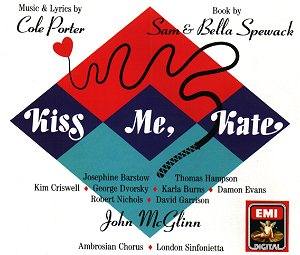
Note: this recording was released in 1990.
Kiss Me Kate gave Cole Porter the opportunity to add his brand of magic to Shakespeare’s The Taming of the Shrew. Kiss Me Kate was, of course, filmed brilliantly by M-G-M in 1953 with the great Howard Keel and Kathryn Grayson leading a cast that included Ann Miller, Tommy Rall, Bobby Van, Bob Fosse, and Kurt Kasznar with Keenan Wynn, and James Whitmore as the two gangsters. The soundtrack recording from that film is still available, to the best of my knowledge.
But I have chosen to review this 1990 recording because: (a) it is in digital stereo sound, (b) it contains all the songs and dances plus material that was dropped before or during rehearsals, (c) in Thomas Hampson, we have a top baritone who can rival Keel; and (d) the booklet notes include all the lyrics so that one can fully savor all the clever Porter wit; the booklet also includes full details about the original stage production. The booklet also includes an interview with Patricia Morison who was Kate in the original Broadway Production which commenced on December 2nd 1948 and ran for 1,077 performances (followed by 400 performances in London).
Kiss Me Kate is a sophisticated and literate, but above all a very funny fable of an egocentric, fabulously flamboyant ex-married couple, Fred and Lilli Vanessi, who have been reunited to co-star in a production of The Taming of the Shrew. The shaky course of their reunion off-stage, is paralleled by the stormy plot of the Shakespeare comedy on-stage.
Porter’s career had been in the doldrums in the 1940s the era of swing – a musical style totally out of joint with his style but with Kiss Me Kate he returned to top form with a score that absolutely brims with good tunes. It ranges in mood from the beautiful love ballads, ‘So in Love’ and ‘Were thine that Special Face’ to the lovely spoof of the Viennese operetta songs, ‘Wunderbar’ (which is so attractive in its own right that people, quite rightly, take it seriously), to the witty patters songs.
The patter songs are probably best remembered. Josephine Barstow as the virago Kate/Lilli sings ‘I Hate Men’ and spitefully spits out such lines as:-
"I hate most the athlete with his manner bold and brassy
He may have hair upon his chest but sisters, so has Lassie!"and –"…From China he will bring you jade and perfume from Araby,
But don’t forget ‘tis he who’ll have the fun and thee the baby,
Oh I hate men,
If thou shouldst wed a businessman, be wary, oh, be wary
He’ll tell you he’s detained in town on business necessary,
His business is the business which he gives his secretary…"Then in Act II as Petruccio/Fred begins to tire of his uphill task in subduing his headstrong wife, he begins to rue his married state and in his song ‘Where is the Life that Late I Led’ he remembers all the girls he’d loved including:-
"where is Rebecca, my Becki-weckio,
could she still be cruising that amusing Ponte Vechio,
Where is Fedora, the wild virago?
It’s lucky I missed her gangster sister form Chicago.
Where is Venetia, who loved to chat so,
could she still be drinkin’ in her stinkin’ pink palazzo?
And lovely Lisa, where are you Lisa?
You gave a new meaning to the leaning tower of Pisa…"Another show-stopper was the gangster’s patter song, ‘Brush up your Shakespeare.’ In which they advise the fellas to:-
"Brush up your Shakespeare,
Start quoting him now,
Brush up your Shakespeare
And the women you will wow
…Just declaim a few lines from "Othella"
and they’ll think you’re a helluva fella
If your blonde won’t respond when you flatter ’er
Tell her what Tony told Cleopaterer.."The bonus items are impressive and would have found respectable places in other musicals. A box set to be treasured alongside the original soundtrack recording.
Reviewer
Ian Lace

OST
EPIC MOODCD30 [59:03]
Save around 22% with
Amazon
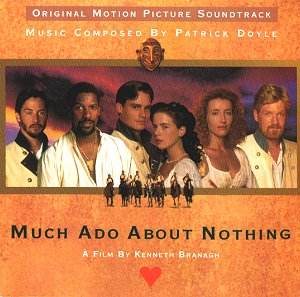
This recording was first released in 1993
This album is a pure delight. Here is a score that really sparkles: from Emma Thomson’s half-sung, half-spoken declamation of ‘Sigh no more ladies’ (Men were deceivers ever) against Doyle’s lovely tune sung warmly on the cellos and then passed sweetly on to the violins that opens the score, to the final chorus of the same refrain as all the lovers are joyfully united in the final cue, ‘Strike up Pipers.’
The Overture thrusts one joyfully, ecstatically into the action. Its wonderful heroic, masculine theme, first heard as Benedick and his fellow soldiers gallop into view, soars jubilantly, full of youthful high spirits. A superb melody. This is contrasted with the more romantic material for the romantic scenes. Another memorable cue is the later rendition of ‘Sigh no more, ladies’ sung by the workers in the garden. What a marvellous tracking shot that was over the beautiful Tuscany garden.
There is so much more to admire too. There is the jolly lute, drum, trumpet and violin music for ‘The Masked Ball’, the magical romantic figures that make up ‘A Star Danced’ and the comic woodwind caperings underscoring Benedick’s eavesdropping on the conversation about Beatrice being in love with him – and the reciprocal violin twitterings as Beatrice struggles to keep up with the maidens as she overhears them swearing Benedick loves her. ‘Pardon goddess of the night’ is a strongly atmospheric piece for choir and orchestra as the torchlight procession makes its way to the tomb of the ‘dead’ Hero.
Recommended unreservedly even if the luvvies thought Ken was so important that his name rather than Shakespeare’s should appear on the front page of the booklet!
Reviewer
Ian Lace

City of Birmingham Symphony Orchestra Conducted by Simon Rattle
EMI CDC 7 49919 2 [59:16]
Save around 22% with
Crotchet
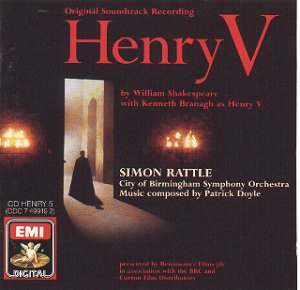
Few film music debuts are as accomplished and nigh astronomical as Patrick Doyle's. A composer formally stuck writing synthesized scores for stage and radio productions made a truthfully invigorating appearance with a full orchestral score that is powerful, assured, sophisticated... a treasure!
This album ought to lead to a concise review, for two reasons:
1) I have nothing but good things to say about it,
2) those who do not have it should not be reading a review, but should be rushing to buy the disc. That may appear somewhat trite, but is probably true nonetheless.Here is a soundtrack that towers above a middling crowd as a score that every lover of great music should hear. The choral 'Non Nobis, Domine' is already a quickly recognizable piece among classical and filmusic buffs alike, whilst Doyle's minstrel strumming of the 'Opening Title,' the theatrical provenience of the 'Henry V Theme,' the resplendent melody for King Henry's compassion in 'The Death of Falstaff,' the tremendous action of 'Once More Unto the Breach,' the saddening, treasonous darkness present in 'The Death of Bardolph,' the unparalleled centerpiece of the score that is 'St. Crispin's Day & The Battle of Agincourt,' the tender love theme from 'The Wooing of Katherine'... all are no less amazing. Doyle uses the 'End Title,' a recording of 'Non Nobis, Domine' minus the symphonic interlude, to crown this off with a feeling of grand finality. One could write entire essays concerning these cues, and could still go on to write paragraphs on the remainders. (I think some actually have.) The score is indiffident, in the finest, non-pejorative sense; a masterpiece in form and function in the most absolute sense.
The music blossoms in the air thanks to a charismatic reading by Simon Rattle and the City of Birmingham Symphony Orchestra. Everything comes together to create an underscore of glorious magnitude. With all of its might and epic splendor, it sounds nearly as timeless as Shakespeare's text.
Reviewer
Jeffrey Wheeler

Music produced by Patrick Doyle and Maggie Rodford, conducted by Robert Ziegler
Sony Classical SK 62857 [76:29]
Save around 22% with
Yalplay

The Triumph of the Prince: Patrick Doyle and Kenneth Branagh's film William Shakespeare's Hamlet
Let's talk about film not as it is, but as it could be. Film as art at the highest level, made without compromise or undue consideration of commerce. Imagine a world in which a major filmmaker could approach the greatest play ever written, and even if that play took four hours to perform, present it complete. Imagine if that filmmaker could bring to the play a fine cast, a supreme technical department and an utterly coherent vision, making the great play relevant to modern audiences. Imagine if that filmmaker could work to the highest standards of presentation, shooting a ravishingly beautiful film in 70mm, creating a work of staggering visual beauty which dwarfed all completing films. Surely for such a film there would be a level of anticipation to rival any previous spectacle? Yet in 1996 such a film was made, it was William Shakespeare's Hamlet, directed by Kenneth Branagh, with music by Patrick Doyle, and it was all but ignored, by critics and public alike.
This article will discuss some aspects of Patrick Doyle's score, and hopefully lead at least some readers reconsidering what the most under-rated film in the entire history of cinema - least some consider this claim unwarranted hyperbole, it is made after 30 years of very regular cinema going and thousands of films seen. Let me first make clear what is being discussed here. When talking about the film I am referring to seeing it in its full-intended majesty in 70mm, with 6-track sound perfectly presented on a screen measuring some 50' wide. This is an entirely different experience to seeing the 35mm reduction on a small multiplex screen, or even worse, enduring the disgracefully grainy and ill-defined video transfer. Seeing the film in 70mm brings the world of the drama fully alive, such that we enter fully into it and the four hours slip by far quicker than many films running less than half that time. When talking about the music score I am referring to the music in its intended context, as a part of the film, unless of course, specifically referring to the soundtrack album. However, I shall sometimes use the titles from the album, which are almost all lines from the play, as an easy way of refering to a particular scene.
First some context: Kenneth Branagh and Patrick Doyle have been working together for well over a decade, with Doyle originally a part of Branagh's Renaissance Theatre Company. They made their cinema debut together with Branagh's outstanding film version of Shakespeare's Henry V, and have since collaborated on Dead Again, Much Ado About Nothing, Mary Shelly's Frankenstein, William Shakespeare's Hamlet, and the forthcoming Love's Labour's Lost. The only Kenneth Branagh directed films he hasn't scored are the comedies Peter's Friends and In the Bleak Midwinter.
Following Doyle's acclaimed scores for Branagh's previous Shakespeare films, Henry V and Much Ado About Nothing, a first encounter with Hamlet via the soundtrack CD may give the impression of a disappointingly understated and subdued score. While the song 'In Pace' (derived from material from the themes for both Hamlet and Ophelia), sung by Placido Domingo, which opens the album, can sound overly theatrical. These first impressions may be difficult to overcome. On screen the song plays over the first half of the end titles, a fittingly operatic requiem as the finale to four hours of high drama, in which context it is as powerful and moving as any song ever written for the screen. Clearly it should come in place at the end of soundtrack album, but was doubtless placed at the beginning to capitalise on Domingo's name. Otherwise the disc is sequenced in film order, and while some cues are inevitably missing (most notably a solemn version of the main theme played on a church organ during an early scene between Ophelia, played by Kate Winslet, and her father and brother, played by Richard Briers and Michael Maloney), it does provide an excellent representation of the full score.
Doyle has crafted a complex score, fully supporting and greatly enhancing Brannagh's vision of Hamlet. The traditional approach has all too often lost any sense of tragedy. Elsinor is portrayed as a place of gothic gloom and misery, and from the onset Hamlet, Prince of Denmark a tormented soul. In such a version there can be no essential tragedy, for there is nothing to lose. Branagh makes Elsinor a place of light and beauty and joy. Hamlet, played by Branagh, is a happy young man, cheerfully in love with his beautiful girlfriend, Ophelia. Tragedy comes via murder and incest, which strikes a rotten blow of corruption at the very heart of the kingdom. Here, as is John Boorman's brilliant version of the Arthurian mythos, Excalibur, "the land and the king are one", such that when a corrupt king, Hamlet's uncle, who has murdered Hamlet's father, Claudius (Brian Blessed), and married his brother's wife, takes to the throne, the land itself is thrown into chaos.
The first semblance of music we hear is a church bell (there is no main title sequence), suggesting the toll for the dead, and soldiers on watch in the dark and snow. This uncanny atmosphere gives way to powerfully staged supernatural terror as Claudius's ghost incarnates through a statue of himself. Thus it becomes immediately clear what is wrong in this demi-paradise, such that while much of the score will be noble, majestic, suffused with an almost Elgarian sense of tragedy, Doyle is able to conjure a virtuoso 10 minute sequence for the main appearance of this apparition. Here Doyle follows Hamlet on a frantic chase through the darkling forest, taking the score into wild, pulsating atonal territory, using the device of a continually restless canon for Claudius, and hence into stark scoring for a bleakly modern string quartet. On screen the ghost of Hamlet's father recounts the crimes committed by his brother, and this is a very real ghost, no Freudian figment of the imagination. Rather, here is a restoration to the play of a world Shakespeare would have recognised, in which people had no difficulty in accepting the reality of the supernatural. Afterwards nature itself rebels, lightening crashes, the very earth sundering in response to the evil destroying the land. Doyle, summoning the fury of the elements unleashed, helps to craft one of the most breathtakingly visionary sequences ever put on film.
Branagh's approach to the play emphasises clarity of purpose and understanding, and Doyle is in his element with subtle underscoring of the key soliloquies of the play. He takes us deep into Hamlet's mind, with the brooding atmosphere of the "To be or not to be" sequence exploring the sonic soundscape territories akin to Jan Gabarek's Nordic jazz. A harp plays through the pastoral melancholy of the music for the speech "If once a window", a folk-like sense of loss and foreboding emerging from the most plaintively beguiling melodies. Elsewhere Doyle's central theme for Hamlet is a work of wondrous lyricism, capable of expressive pain, heroic nobility and many shades between, while a secondary theme for Ophelia has a simple, haunting loveliness, which captures the tragedy not just of a love denied, but a life sacrificed.
Before the intermission Doyle builds the drama to a new height, with Hamlet in the winter snows, an invading advancing army far below, as the Prince of Denmark declares "My thoughts be Bloody" and imperious drums sound a defiantly rousing tattoo. Here, as clearly as anywhere, the influence of the epic 1967 Russian version of War and Peace can be witnessed on Branagh's bold conception of Shakespeare's version of similarly universal themes.
After the intermission, which comes exactly two-thirds of the way through the film, Branagh builds the remaining 80 minutes like a relentless thriller, aided by Doyle's intensely powerful writing, escalating the drama to an epic fever pitch such as the screen has rarely seen. The final sequences of betrayal and slaughter in the throne room achieve an extraordinary sense of the timeless intensity of destiny being fulfilled before ones very eyes and ears. Yet inter-cut with the arrival and storming of Elsinor by the invading army, come to restore the just rule of law, the film presents a sense of tragic sacrifice made heroic and necessary, Hamlet's death a vital atonement for the restoration of the land. Tellingly, the music moves from violence to choral lament, through the mourning of 'In Pace', to the celebratory triumph of the latter part of the end titles (by which point 99% of the audience has left the auditorium) such that, as in all the greatest films, the story is told through the music. Hamlet continues through the titles, the song rightfully sorrowful for life lost so young and in the prime of love, yet rising to a heroic finale entirely in keeping with Branagh's vision, in which the final image is a statue of Hamlet being demolished and unceremoniously removed. The tragedy is over and now life can go on, the kingdom renewed. The final effect is exhilarating, uplifting almost transcendent, a testament to the overwhelming power of absolute cinema.
In an era of small, intelligent films, and big but empty blockbusters, William Shakespeare's Hamlet towers over everything else the decade has produced. Branagh's film is a monumental achievement, quite simply one of the very finest films ever made, and instrumental in this quality is the superb musical score by Patrick Doyle. If you have never seen this film properly, and given that there were on only two 70mm prints made for the UK, and few cinemas left in this multiplex era capable of showing them it is not an easy thing to do, then do make it a priority. Forget all other films, except perhaps the previously mentioned War and Peace, for this is the one to see. If there is a cinema with a 70mm projector near you, pester the management until they relent and show it. If not, travel to the next available screening. But whatever you do, see it, this is real cinema, and Patrick Doyle's score is an integral part of the glory of William Shakespeare's Hamlet.
Reviewer
Gary S. Dalkin

Music from the Shooting Gallery Motion Picture
VARÈSE SARABANDE VSD–6043 [30:54]
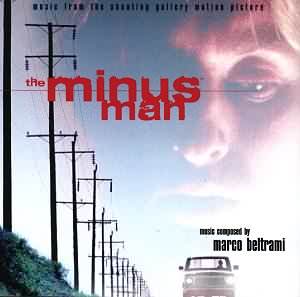
Marco Beltrami studied music with Luigi Nono in Venice then at the Yale School of Music. Now resident in Los Angeles, Beltrami studied the art of film scoring with Jerry Goldsmith. 1999 is certainly the year of the Italians and Italian-born and educated film composers. Here is another innovative score inhabiting a sound world that is as far off the beaten track of the usual film score as one could imagine.
Programme out the rather crass Pop elements performed by Bryony Atkinson and Inara George and you are left with some14 innovative and often riveting tracks. Main Title, begins with that sort of sound you hear when you course a damp finger round the rim of a glass. This arresting sound is followed by tubular bells, solo soprano, brushed cymbals and what might be a didgeridos, steel cans and an implement that suggests horses hooves plus piano and violin all combining to sing a melancholy romantic song that forms the main theme. The steel cans and hooves are appropriate to the next cue entitled ‘that truck is a horse of death’ in which the same instrumental quirkiness takes over, but this time there is a palpable sense of menace with a surprising tango-rhythm inflecting the closing bars. .’The mechanics of vann’ has the same basic instrumentation but sounds like typical hillbilly music; a style that is even more pronounced in the aptly-named postal shuffle. ‘At home’ is a tender statement of the main theme. ‘Ranchos Bolero’ is a moody tango with tambourines, drums and solo violin playing gypsy-style before the whole slides into a grotesque howling.
‘Scatback’s dream is an eerie ‘heavenly’ almost childish vision until a droning bass crushes its serenity and all turns ugly black. ‘The funeral’ predominates the gloom under weirdly ‘dripping’ bells. ‘Hunt for gene’ is a quieter more introspective cue with the emphasis on violin and piano nostalgic melancholy with the quirky instrumentation held at bay but ‘Christmas’ sees the return of that odd glass-rim effect that introduced the main title as it sings a rather plaintive carol-like version of the main theme.
An extraordinary, fascinating album
Reviewer
Ian Lace

Last month you might remember we reviewed new albums for Deep Blue Sea and The Iron Giant and I complained about the scant time given to the original music of Trevor Rabin and Michael Kamen. Well, just to confuse everybody, this month we have two more albums for Deep Blue Sea and The Iron Giant but this time comprising fuller scores from the two composers. Film Music on the Web deplores this trend which is becoming more and more prevalent. Similar CD booklet designs don’t help either (particularly in the case of Deep Blue Sea). We wonder what the Trades Description people might make of it all?
OST
VARÈSE SARABANDE VSD-6063 [30:13]
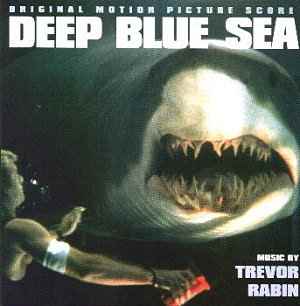
If you've only just seen the film, you need to retrieve your brain before listening to the music and reading any reviews. Alzheimer's saving intelligent mutant killer sharks on the loose ? How the Hell does a composer react to pitch like that ?
Rabin totally ignores any approaches previously taken for shark movies (there were a couple, right ?) and instead dives further into his orchestra 'n' electronics Armageddon style laced with trademark guitar. For all the gung-ho nonsense of the supposedly intelligent characters, this music works a treat. The finale cue ("Aftermath") is sequenced first, so that we get an heroic musical introduction to the score. It doesn't take very long for the cacophonic attacks to commence (halfway through "Journey"), and once they do you have the rest of disc pegged. "Anarchy" is the very best of these, with a frenetic pace sustained as the idiots get picked off one by one.
The score may not exactly break new ground, but it keeps its head above water with spots of innovation when many other action blockbusters don't even try.
Reviewer
Paul Tonks

There are more >>>> [ Part 1 ] [ Part 2 ] [ Part 3 ] [ Part 4 ]
Return to November index
 Search the Crotchet database from here
Search the Crotchet database from here
| Discs
on these pages are offered for sale. There is also a page of search
engines from a selection of on-line retailers
here.
Please support this web-site by buying your discs here. Disclaimer: Every effort is made to make sales links to the correct disc but, in the end, you must take responsibility for checking that what you are purchasing is what you want. Some of these discs were not actually available for sale at the time of posting but a link has been made in anticipation of their forthcoming availablility. |
Return To Film Music on the Web
e-mail: info@musicweb.uk.net